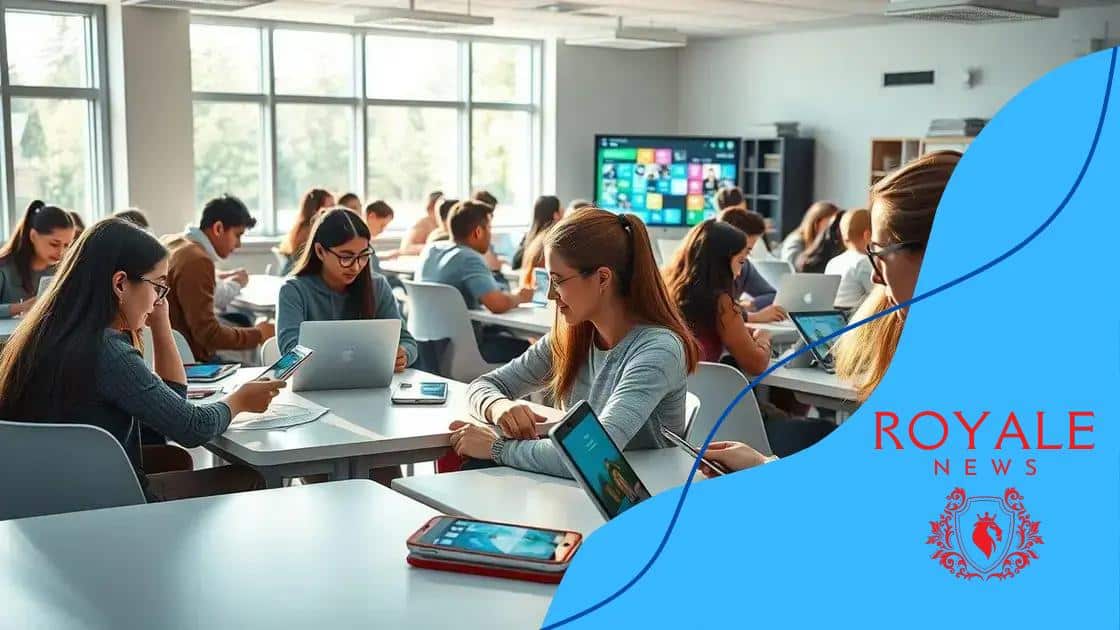AI tracking student progress and engagement

AI tracking student progress and engagement leverages technology to personalize learning experiences, enhance real-time feedback, and improve educational outcomes while addressing challenges such as data privacy and the need for teacher training.
AI tracking student progress and engagement is reshaping how we think about education. Imagine a classroom where technology helps teachers understand student needs better. What could that mean for learning?
Understanding AI in education
Understanding AI in education is essential for grasping how technology influences learning experiences. As schools adopt more digital tools, the role of AI becomes increasingly vital.
AI can help personalize education to meet individual student needs. For example, it analyzes data to identify strengths and weaknesses, allowing teachers to tailor their approaches. This is not just about tracking performance; it’s about creating a supportive environment for every learner.
What Does AI Do in the Classroom?
AI systems can manage various tasks, making life easier for teachers and students. They automate administrative duties and provide valuable insights into classroom dynamics. Here are some key benefits:
- Streamlined grading processes
- Personalized learning recommendations
- Enhanced student engagement during lessons
With AI tools, educators can monitor student progress in real time. This means they can intervene early if a student is struggling. For instance, if a student consistently performs poorly on quizzes, AI can flag this issue, prompting the teacher to offer help.
The Role of Data in Understanding Students
The data collected by AI programs is a treasure trove of information. It offers insights into learning patterns and behavior. When educators leverage this data, they can enhance lesson planning and increase engagement. Imagine knowing exactly how a student learns best! This knowledge allows teachers to adapt their methods and ensure optimal learning outcomes.
Furthermore, students benefit from AI by receiving real-time feedback on their strengths and areas for improvement. When they understand where they stand, it empowers them to take charge of their learning journey. AI encourages autonomy and fosters a desire to improve.
Impact of AI on student progress tracking
The impact of AI on student progress tracking is significant in modern education. Schools are increasingly using AI tools to monitor how students learn and grow.
AI helps teachers gain insights into each student’s progress through detailed data analysis. This information is invaluable for tailoring lessons and providing additional support. As a result, students benefit from a more individualized learning experience.
How AI Revolutionizes Tracking
One major way AI changes tracking is through real-time data collection. Unlike traditional methods, AI systems continuously gather data on student performance. This leads to:
- Immediate feedback for teachers and students
- Identification of learning gaps quickly
- Enhanced ability to adjust teaching methods
Teachers can quickly see where a student might be struggling, allowing them to intervene sooner rather than later. This proactive approach helps ensure that no student falls behind.
The Role of Predictive Analytics
AI uses predictive analytics to forecast future performance based on current data. This helps educators understand potential challenges students may face. By anticipating needs, schools can implement support systems ahead of time. For example, if data shows that a group of students struggles with a particular concept, teachers can address it before the next exam.
Moreover, AI tools allow for greater engagement among students. When students know their progress is being tracked closely, they often feel more responsible for their learning. This responsibility can lead to higher motivation and better outcomes. AI encourages a culture of continuous improvement, both for students and educators alike.
Benefits of AI for engagement

The benefits of AI for engagement in education are profound. AI tools are transforming how students interact with learning materials. By personalizing educational experiences, AI fosters a more engaging environment.
One notable advantage is the ability to tailor content to fit individual needs. For example, AI can analyze a student’s strengths, weaknesses, and preferences. This analysis allows teachers to create customized learning paths that resonate with each learner.
Enhancing Interaction
With AI, classrooms become more interactive. Students engage with subjects in ways that are relevant to them. This might include:
- Gamified learning experiences that make education fun
- Instant feedback on assignments and assessments
- Interactive simulations that deepen understanding
Such engagement not only keeps students interested but also improves knowledge retention. When students find learning enjoyable, they are more likely to participate actively and collaborate with peers.
Creating a Collaborative Learning Environment
AI tools also facilitate collaboration among students. By connecting learners with similar interests or difficulties, it encourages teamwork. Students can work together on projects, helping each other grasp challenging concepts. This spirit of cooperation can lead to greater academic success.
Additionally, AI helps teachers identify when students struggle, allowing them to provide support promptly. The more informed teachers are about student engagement levels, the better they can address varying needs. AI thus serves as a valuable partner in the classroom.
Challenges of implementing AI in schools
The challenges of implementing AI in schools are significant and multifaceted. While AI offers great potential, many obstacles must be addressed to make it effective in education.
One of the primary challenges is the lack of resources. Many schools operate on tight budgets, making it difficult to invest in AI technologies, training, and infrastructure. Without sufficient funding, schools may struggle to adopt new tools that enhance learning.
Training and Familiarization
Another major concern is the need for adequate training for educators. Many teachers are not familiar with AI technologies and may find it challenging to integrate them into their teaching practices. This unfamiliarity can lead to hesitance or resistance to using AI tools.
Professional development is vital, yet often overlooked. Schools need to ensure that educators receive ongoing support and training on how to use AI effectively. When teachers feel confident in these tools, they can better support student learning.
Data Privacy and Security
Data privacy is a critical issue when using AI in schools. With AI systems collecting vast amounts of student data, there must be strict safeguards to protect this information. Parents and educators often worry about how data is stored and used. Clear policies are necessary to address these concerns and maintain trust.
Moreover, ensuring that AI systems are unbiased is another challenge. Algorithms may inadvertently reflect biases present in their training data. Schools must ensure that the AI tools they choose promote equity and do not exacerbate existing inequalities among students.
Future trends in AI for education
The future trends in AI for education are exciting and full of potential. As technology continues to evolve, so does its application in the classroom. AI is set to change how students learn and teachers instruct.
One major trend is the integration of AI with personalized learning. AI tools will increasingly adapt to the learning styles, speeds, and preferences of individual students. This means each learner can have a unique educational experience tailored specifically to their needs.
Adaptive Learning Technologies
Adaptive learning technologies are becoming commonplace. These systems assess a student’s performance in real time and adjust the curriculum accordingly. For example:
- Content can be modified to provide additional practice for struggling students.
- Advanced students can be given more challenging materials to keep them engaged.
- Feedback can be immediate, helping students correct mistakes quickly.
Such technologies increase engagement and foster a sense of ownership over learning. Students can progress at their own pace, which boosts confidence and motivation.
AI-Powered Virtual Classrooms
Another trend is the rise of AI-powered virtual classrooms. These environments leverage technology to create interactive learning experiences beyond the traditional classroom. Students can engage in:
- Virtual reality (VR) lessons that transport them to different environments, enhancing learning.
- Interactive simulations that make content more relatable.
- Collaborative projects with peers around the globe, promoting cultural exchange.
This tech not only makes learning more enjoyable but also prepares students for a world increasingly dominated by technology.
In conclusion, the integration of AI in education brings numerous benefits while also presenting challenges. As schools strive to implement these technologies, they must focus on personalized learning, adaptive tools, and maintaining data privacy. Moving forward, embracing AI will help create more engaging, inclusive, and effective classrooms. With the right support, educators can harness AI to improve student outcomes and better prepare them for the future.
\n\n
\n
FAQ – Frequently Asked Questions about AI in Education
What are the main benefits of AI in education?
AI enhances personalized learning, improves student engagement, and provides real-time feedback for both students and teachers.
How can teachers be supported in using AI tools?
Teachers need ongoing training and resources to confidently integrate AI into their teaching methods, including professional development workshops.
What are the concerns regarding data privacy with AI in schools?
Data privacy concerns include the protection of student information and ensuring that AI systems use data responsibly without compromising student safety.
What trends can we expect in the future of AI for education?
Future trends include more adaptive learning technologies, virtual classrooms, and AI-driven analytics to better meet the needs of individual students.





